Philips M3861A, M3860A User Manual
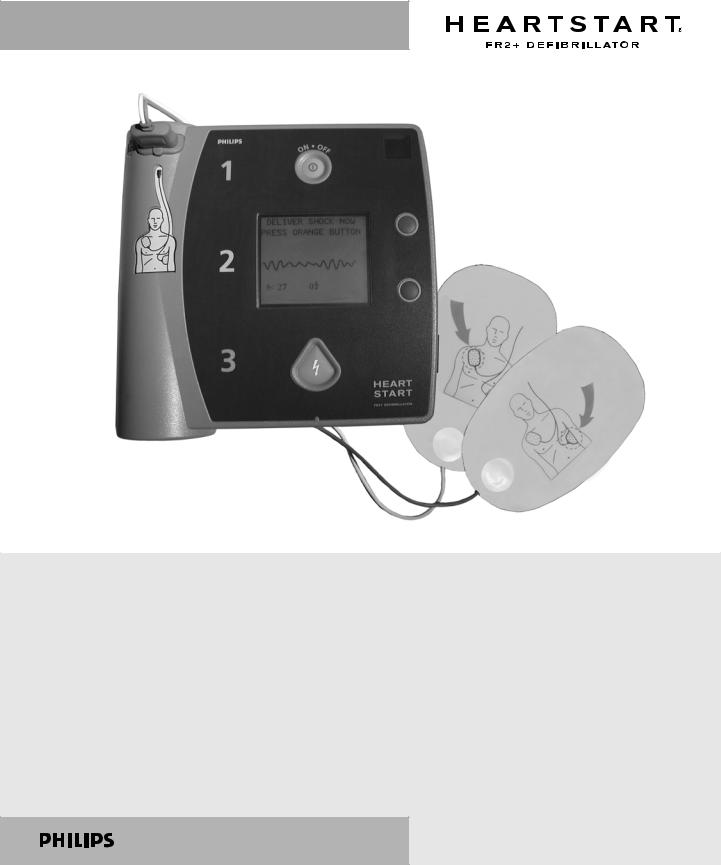
P O W E R T O S A V E A L I F E
H E A R T S T A R T F R 2 + D E F I B R I L L A T O R
I N S T R U C T I O N S F O R U S E
M3860A, M3861A
Edition 10
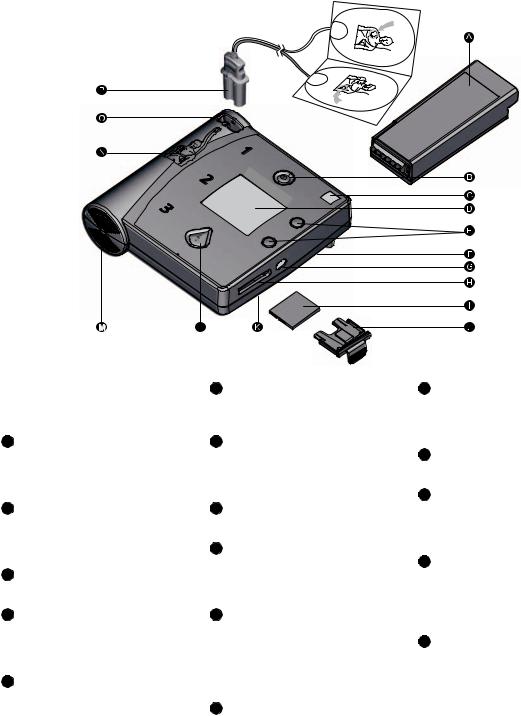
The HeartStart FR2+ Defibrillator
Clockwise from top right.
A Battery. Standard long-life or rechargeable battery used to power the FR2+. (Check local regulations for disposal and recycling requirements.)
Battery. Standard long-life or rechargeable battery used to power the FR2+. (Check local regulations for disposal and recycling requirements.)
B On/Off button. Turns on the FR2+ and starts voice and screen prompts. Second press turns off the FR2+.
On/Off button. Turns on the FR2+ and starts voice and screen prompts. Second press turns off the FR2+.
C Status Indicator. Shows you the readiness status of the FR2+.
Status Indicator. Shows you the readiness status of the FR2+.
D Display screen. Displays text prompts and incident data. The FR2+ M3860A screen also displays the patient’s ECG.
Display screen. Displays text prompts and incident data. The FR2+ M3860A screen also displays the patient’s ECG.
E Option buttons. Adjust the contrast of the screen display and control special functions.
Option buttons. Adjust the contrast of the screen display and control special functions.
F Beeper port. Broadcasts alert beeps when required. It is located under the right edge of the FR2+.
Beeper port. Broadcasts alert beeps when required. It is located under the right edge of the FR2+.
G Infrared (IR) communications port. A special lens, or “eye,” used to transfer data directly to or from another device.
Infrared (IR) communications port. A special lens, or “eye,” used to transfer data directly to or from another device.
H Data card port. Receptacle for data card tray.
Data card port. Receptacle for data card tray.
I  Data card (optional). Used to store and review information about an incident, including ECG and optional voice recording.
Data card (optional). Used to store and review information about an incident, including ECG and optional voice recording.
J  Data card tray. Special sleeve that holds the data card and fits into the data card port to help seal the FR2+ against fluids. The tray should be kept installed in the FR2+ even if no data card is used.
Data card tray. Special sleeve that holds the data card and fits into the data card port to help seal the FR2+ against fluids. The tray should be kept installed in the FR2+ even if no data card is used.
K Microphone. Used optionally to record surrounding audio during an incident. It is located under the right edge of the FR2+.
Microphone. Used optionally to record surrounding audio during an incident. It is located under the right edge of the FR2+.
L  Shock button. Controls shock delivery. The button flashes when the HeartStart FR2+ is ready to deliver a shock.
Shock button. Controls shock delivery. The button flashes when the HeartStart FR2+ is ready to deliver a shock.
M Speaker. Amplifies voice prompts during use of the FR2+.
Speaker. Amplifies voice prompts during use of the FR2+.
N Pads placement diagram.
Pads placement diagram.
Illustrates correct placement of pads.
Diagrams are also shown on the defibrillator pads.
O Defibrillator pads connector socket. Receptacle for connector of the defibrillator pads cable. An adjacent LED light flashes to show socket location and is covered when connector is inserted.
Defibrillator pads connector socket. Receptacle for connector of the defibrillator pads cable. An adjacent LED light flashes to show socket location and is covered when connector is inserted.
P Adult defibrillator pads. Selfadhesive pads with attached cable and connector.
Adult defibrillator pads. Selfadhesive pads with attached cable and connector.
P hilip s Med ical Systems
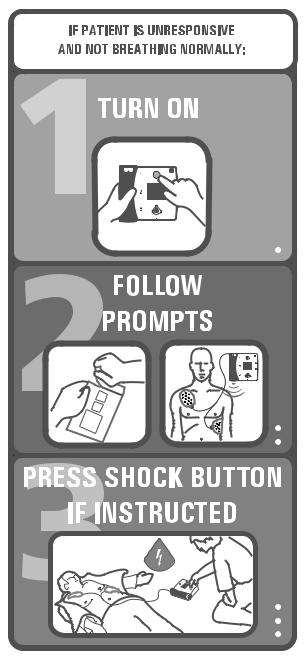
H E A R T S T A R T F R 2 + D E F I B R I L L A T O R
Q U I C K R E F E R E N C E C A R D
P hili ps Me dical Sy stems
Intentionally left blank.
P hili ps Me dical Sy stems

H E A R T S T A R T F R 2 +
M3860A, M3861A Defibrillator
I N S T R U C T I O N S F O R U S E
Edition 10
P hili ps Me dical Sy stems

Instructions for Use
Equipment specifications are subject to alteration without notice. All changes will be in compliance with regulations governing manufacture of medical equipment.
Printed in the U.S.A.
Publication date: August 2003
Publication number: M3860-91900
Part number: 011120-0010
© 2003 Philips Electronics North America Corp.
No part of this publication may be reproduced, transmitted, transcribed, stored in a retrieval system or translated into any human or computer language in any form by any means without the consent of the copyright holder.
Unauthorized copying of this publication may not only infringe copyright but also reduce the ability of Philips Medical Systems to provide accurate and up-to-date information to users and operators alike.
Philips Medical Systems reserves the right to make changes in specifications or to discontinue any product at any time without notice or obligation and will not be liable for any consequences resulting from the use of this publication.
Authorized EU Representative
Philips Medizinsysteme Boeblingen GmbH
Hewlett-Packard Strasse 2
71034 Boeblingen, Germany
(+49) 7031-14-5151
CAUTION
FEDERAL LAW (USA) RESTRICTS THIS DEVICE TO SALE BY OR ON THE ORDER OF A PHYSICIAN.
The HeartStart FR2+ is designed to be used only with Philipsapproved accessories. The HeartStart FR2+ may perform improperly if non-approved accessories are used.
Device Tracking
In the U.S.A., this device is subject to tracking requirements by the manufacturer and distributors. If the defibrillator has been sold, donated, lost, stolen, exported, or destroyed, notify Philips Medical Systems or your distributor.
Device Manufacturer
The HeartStart FR2+ Defibrillator is manufactured by Philips Medical Systems, Seattle, Washington, USA.
P hili ps Me dical Sy stems
M3860A/M3861A HEARTSTART FR2+

P hili ps Me dical Sy st ems
Contents
1 Introduction to the HeartStart FR2+ |
|
What is the HeartStart FR2+? ................................................................. |
1-1 |
When Is the HeartStart FR2+ Used? .................................................... |
1-2 |
How Does the HeartStart FR2+ Work? ................................................ |
1-2 |
How Is the HeartStart FR2+ Supplied? ................................................ |
1-3 |
2 Preparing Your HeartStart FR2+ for Use |
|
Overview ....................................................................................................... |
2-1 |
Installing the Battery ................................................................................... |
2-1 |
Setting the Clock ........................................................................................ |
2-3 |
Running the Battery Insertion Selftest .................................................... |
2-4 |
Placing and Securing the HeartStart FR2+ .......................................... |
2-5 |
3 Using Your HeartStart FR2+ |
|
Overview ....................................................................................................... |
3-1 |
Step 1: Preparation .................................................................................... |
3-2 |
Step 2: ECG Analysis and Monitoring ................................................... |
3-3 |
Step 3: Shock Delivery .............................................................................. |
3-4 |
ECG Display for Ongoing Observation ................................................. |
3-5 |
4 Maintaining, Testing, and Troubleshooting
Your HeartStart FR2+
Overview ....................................................................................................... |
4-1 |
Maintenance ................................................................................................. |
4-1 |
After Using the HeartStart FR2+ ............................................................. |
4-2 |
Cleaning the HeartStart FR2+ ......................................................... |
4-3 |
Operator’s checklist ............................................................................ |
4-3 |
Testing ........................................................................................................... |
4-5 |
Battery insertion selftest .................................................................... |
4-5 |
Periodic selftests ................................................................................. |
4-9 |
Device history ....................................................................................... |
4-9 |
Battery History ..................................................................................... |
4-10 |
Troubleshooting Guide .............................................................................. |
4-11 |
Status indicator summary .................................................................. |
4-11 |
Recommended action during an emergency ................................ |
4-11 |
Troubleshooting during patient use ................................................ |
4-12 |
General troubleshooting .................................................................... |
4-14 |
1

2
5 Clinical and Safety Considerations
Clinical Considerations .............................................................................. |
5-1 |
Indications ............................................................................................. |
5-1 |
Contraindications ................................................................................ |
5-1 |
Safety Considerations ................................................................................ |
5-1 |
General dangers, warnings, and cautions ..................................... |
5-2 |
Defibrillation warnings and cautions ............................................... |
5-4 |
Monitoring cautions ............................................................................ |
5-5 |
Maintenance cautions ........................................................................ |
5-5 |
6 Setup and Advanced Mode Features
Setup Overview ........................................................................................... |
6-1 |
Non-protocol parameters .................................................................. |
6-1 |
Automatic protocol parameters ....................................................... |
6-2 |
Manual override parameters ............................................................. |
6-4 |
Using Setup Features ........................................................................ |
6-5 |
Reviewing current setup .................................................................... |
6-6 |
Revising setup ...................................................................................... |
6-6 |
Receiving setup ................................................................................... |
6-7 |
Reading setup ...................................................................................... |
6-8 |
Sending and Receiving Clock Settings ................................................. |
6-8 |
Using Advanced Mode Features ............................................................. |
6-9 |
Using the manual analyze feature .................................................... |
6-10 |
Using the manual charge feature (M3860A only) ........................ |
6-11 |
7 Data Management and Review
Overview ....................................................................................................... |
7-1 |
Recording Incident Data ............................................................................ |
7-1 |
Recording data in internal memory ................................................. |
7-1 |
Recording data on a data card ........................................................ |
7-1 |
Reviewing Incident Data ............................................................................ |
7-3 |
Reviewing data from internal memory ............................................ |
7-3 |
Reviewing data from a data card ..................................................... |
7-4 |
P hili ps Me dical Sy st ems
M3860A/M3861A HEARTSTART FR2+

|
3 |
|
|
Appendices |
|
A Accessories for the HeartStart FR2+ |
|
HeartStart Accessories ............................................................................. |
A-1 |
Suggested Additional Items ..................................................................... |
A-2 |
B Technical Specifications |
|
HeartStart FR2+ Defibrillator Specifications ........................................ |
B-1 |
Accessories Specifications ...................................................................... |
B-6 |
C Glossary of Symbols and Controls |
|
Instructions for Use ..................................................................................... |
C-1 |
HeartStart FR2+ M3860A and M3861A Defibrillator |
|
Symbols and Controls ................................................................................ |
C-1 |
Accessories Symbols ................................................................................. |
C-3 |
D Glossary of Terms
Index
P hili ps Me dical Sy st ems
Contents

Notes
P hili ps Me dical Sy st ems
M3860A/M3861A HEARTSTART FR2+

P hili ps Me dical Sy stems
1
1 Introduction to the HeartStart FR2+
What is the HeartStart FR2+?
The HeartStart FR2+ Defibrillator (“FR2+”) is an automated external defibrillator. It is compact, lightweight, portable, and battery powered. It is designed for simple and reliable operation by a trained responder.
N O T E : The HeartStart FR2+ is an enhanced version of the defibrillator previously sold as the Heartstream FR2. The FR2+ has all the features of the FR2. All accessories compatible with the FR2 are also compatible with the FR2+. However, the FR2+ has some new features not present in the FR2 and can be used with certain accessories (labeled FR2+) that are not compatible with the FR2.
The FR2+ has a Status Indicator that is always active, so you can tell at a glance if it is ready for use. The front panel of the FR2+ has an On/Off button at the top and a Shock button at the bottom. A display screen in the center of the panel provides text prompts and incident information. Voice prompts are provided through a speaker located at the base of the FR2+. (See the diagram on the inside front cover for details.)
The FR2+ is available in two models, the M3860A and the M3861A. They share a set of basic features, detailed in Chapter 6. The principle differences between the two models are identified below:
model M3860A |
model M3861A |
|
|
Configurable ECG display on screen |
Text prompt display on screen, no ECG |
|
display |
|
|
Configurable manual charge in |
No manual charge in advanced mode |
advanced mode |
|
|
|
N O T E : The FR2+ comes with a factory default setup that can be modified. (See Chapter 6, “Setup and Advanced Mode Features,” for a description of setup defaults and options.)
1-1

1-2
When Is the HeartStart FR2+ Used?
The HeartStart FR2+ Defibrillator is used with disposable defibrillator pads applied to a person who is experiencing the symptoms of sudden cardiac arrest (SCA): lack of responsiveness and lack of breathing. Defibrillation should not be performed on anyone who is responsive or is breathing.
Infant/child reduced-energy defibrillator pads are available for use with the FR2+ on children under the age of 8 or weighing less than 55 pounds (25 kg).
The FR2+ is intended for use by emergency care personnel who have been specifically trained in the operation of the FR2+ or who are qualified by training in Basic Life Support (BLS), in Advanced Life Support (ALS), or in other physician-authorized emergency medical response.
At the discretion of emergency care personnel, the M3860A FR2+ with ECG display enabled can also be used with the FR2+ ECG assessment module to display the rhythm of a responsive or breathing patient, regardless of age. The FR2+ Defibrillator used with the FR2+ ECG assessment module provides a non-diagnostic display for attended patient monitoring. While connected to the FR2+ ECG assessment module, the FR2+ displays and evaluates the patient's ECG and disables its shock capability.
How Does the HeartStart FR2+ Work?
The HeartStart FR2+ Defibrillator is designed to provide external defibrillation therapy to someone in cardiac arrest. Defibrillation therapy is the best available way to treat a variety of potentially fatal heart arrhythmias.
The FR2+ is extremely easy to use. When connected to defibrillator pads that are properly applied to the patient’s bare chest, the FR2+:
1.prompts you to take specific actions,
2.automatically analyzes the patient's heart rhythm and advises you whether or not the rhythm is shockable, and
3.arms the Shock button, if appropriate, and instructs you to press it to deliver a biphasic electric pulse designed to defibrillate the heart.
Detailed instructions for use are provided in Chapter 3.
P hili ps Me dical Sy stems
M3860A/M3861A HEARTSTART FR2+

1-3
1
How Is the HeartStart FR2+ Supplied?
The HeartStart FR2+ Defibrillator is supplied with a standard long-life battery, two sets of adult defibrillator pads with integrated cable and connector, and a data card tray. Other accessories, including an FR2+ rechargeable battery, FR2 infant/child reduced-energy defibrillator pads, and (for M3860A only, with ECG display enabled) a three-wire FR2+ ECG assessment module, are available. See Appendix A for a list of accessories and other recommended supplies.
P hili ps Me dical Sy stems
Introduction to the HeartStart FR2+

Notes
P hili ps Me dical Sy stems
M3860A/M3861A HEARTSTART FR2+
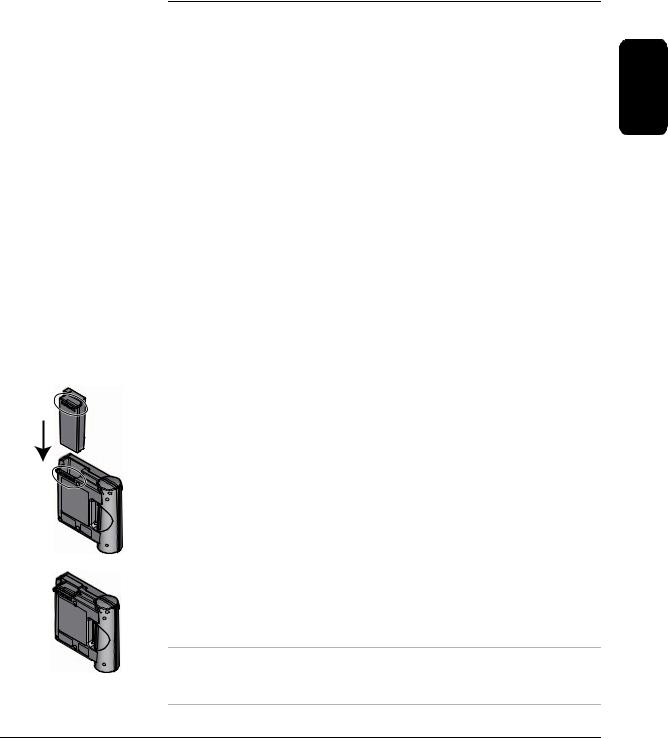
P hili ps Me dical Sy stems
2Preparing Your HeartStart FR2+ for Use
2
Overview
There are a few basic steps to preparing your HeartStart FR2+ Defibrillator for use:
Install data card (optional).
Install a battery.
Set the clock in the FR2+ (optional).
Run the battery insertion selftest.
Place the FR2+ with recommended accessories in a convenient location.
The instructions presented here briefly describe the normal sequence of preparation. It assumes that you are using a fresh battery, that the selftest passes, that you are not using a data card, and that the factory default settings will not be changed. Exceptions to this sequence are provided elsewhere in this manual.
Installing the Battery
The HeartStart FR2+ Defibrillator is shipped with a M3863A standard, long-life battery. The battery is enclosed in a gray plastic case. There is a yellow latch at one end that holds the battery in place when it is correctly installed in the FR2+. (The optional M3848A FR2+ rechargeable battery is enclosed in a blue plastic case and also has a yellow latch. Except where otherwise noted, the following information applies to both battery types.)
Before installing the battery, make sure the defibrillator pads are not connected to the FR2+. To install the battery:
1.Hold the battery by the latch end and slide it into the battery compartment at the top of the FR2+.
2.Slide the battery all the way into the opening, until the latch clicks into place. The latch will click into place only when the battery is inserted correctly.
C A U T I O N : Follow all instructions supplied with the HeartStart M3863A standard battery. Install the battery before the install-by date shown on the battery.
2-1
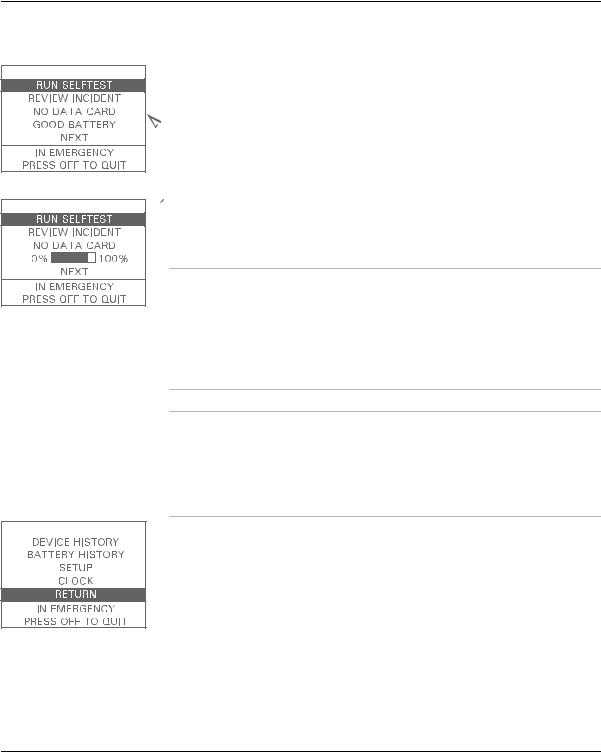
2-2
When the battery is installed, the FR2+ automatically turns on. The Status Indicator displays a flashing black hourglass. The Shock button light and the indicator light for the defibrillator pads connector socket turn on briefly.
The display screen brings up the main menu. From this menu, you can start the FR2+ battery insertion selftest, review information from the last time the  FR2+ was used, or go to the next screen for other options. Information about the optional data card and the battery status is also provided. (See Chapter
FR2+ was used, or go to the next screen for other options. Information about the optional data card and the battery status is also provided. (See Chapter
7, “Data Management and Review,” for details about reviewing an incident and using a data card.) For the M3863A standard battery, a GOOD BATTERY message should be displayed. For the M3848A FR2+ rechargeable battery,  a “fuel gauge” graphic illustrates remaining power. Throughout the remainder of this manual, the screen displays illustrated will be for the standard battery unless otherwise noted.
a “fuel gauge” graphic illustrates remaining power. Throughout the remainder of this manual, the screen displays illustrated will be for the standard battery unless otherwise noted.
N O T E : This screen will not be displayed if the FR2+ is connected to defibrillator pads (that are applied to the patient) when the battery is inserted, and you will not be able to access the menu items. In addition, the battery insertion selftest and periodic automatic selftests cannot run while the defibrillator pads are connected to the patient. Be sure to unplug the pads connector from the FR2+ after each use. Do not store the FR2+ with the pads connected.
N O T E : To move around the menus displayed, use the Option buttons as follows:
•Press the LOWER Option button to move the highlight bar from one item to another on the menu.
•Press the UPPER Option button to select the highlighted item or to scroll through the settings for that item.
If you select NEXT, the menu displayed lets you review the history of the FR2+, review the history of the battery being used, access setup data, set
 the clock, or return to the first menu. (See Chapter 4, “Maintaining, Testing, and Troubleshooting Your HeartStart FR2+,” for details about the review options and Chapter 6, “Setup and Advanced Mode Features,” for information on the setup option.)
the clock, or return to the first menu. (See Chapter 4, “Maintaining, Testing, and Troubleshooting Your HeartStart FR2+,” for details about the review options and Chapter 6, “Setup and Advanced Mode Features,” for information on the setup option.)
P hili ps Me dical Sy stems
M3860A/M3861A HEARTSTART FR2+
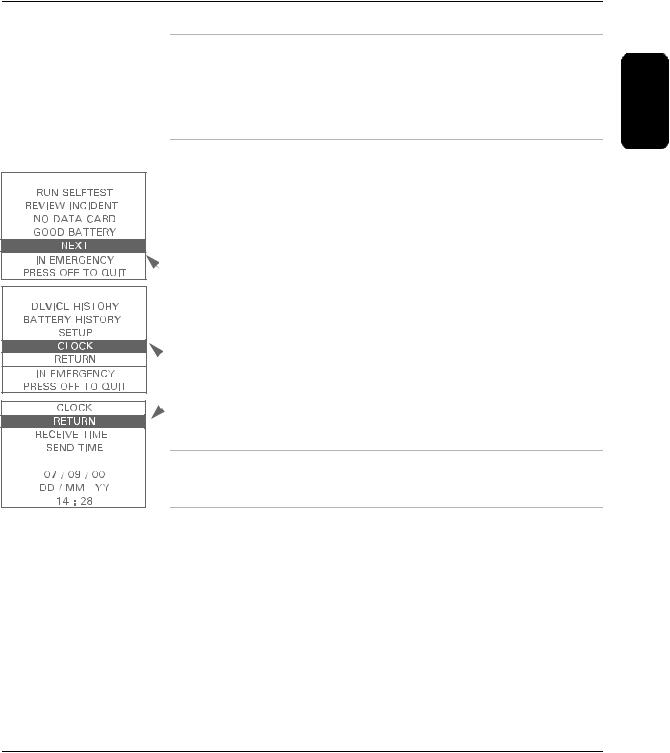
P hili ps Me dical Sy stems
2-3
N O T E : If you make no selection for 10 seconds, the selftest will automatically run. If you want to select something different from either of these menus, you must do so before the selftest begins, or remove and
reinstall the battery to bring up the main menu. You can press the On/Off 2 button at any time to turn off the FR2+ and return it to standby (ready for
use) mode. To use the FR2+, press the On/Off button again.
Setting the Clock
It is recommended that the first time you prepare your HeartStart FR2+ Defibrillator for use, you check the FR2+’s internal clock to be sure it is set to the correct date and local time. You can reset it if necessary.
To see the clock settings, select NEXT from the first menu, within 10 seconds of installing the battery, and then select CLOCK. To do this:
1. Press the lower Option button to move the highlight bar to NEXT.
2. Press the upper Option button to bring up the NEXT screen.

 3. Press the lower Option button to move the highlight bar to CLOCK.
3. Press the lower Option button to move the highlight bar to CLOCK.
4. Press the upper Option button to bring up the CLOCK screen.

 The CLOCK screen displays the date and time currently set in the internal clock of the FR2+.
The CLOCK screen displays the date and time currently set in the internal clock of the FR2+.
N O T E : The date is displayed as day (DD), month (MM), and year (YY), as shown on the screen. The time is displayed using the 24-hour international clock.
If no changes to the clock settings are needed, select RETURN and go back to the first menu. If the date and time are not correct, there are two ways to set them:
Receive the clock settings from another FR2+ or from a computer using HeartStart Event Review® software,* using the RECEIVE TIME option. This may be used to synchronize the clocks of several FR2+s. You can also send the clock settings from one FR2+ to another one, using the
SEND TIME option. See Chapter 6, “Setup and Advanced Mode
Features,” for instructions.
Manually set the date and the time.
*HeartStart Event Review software was previously sold as CodeRunner software.
Preparing Your HeartStart FR2+ for Use
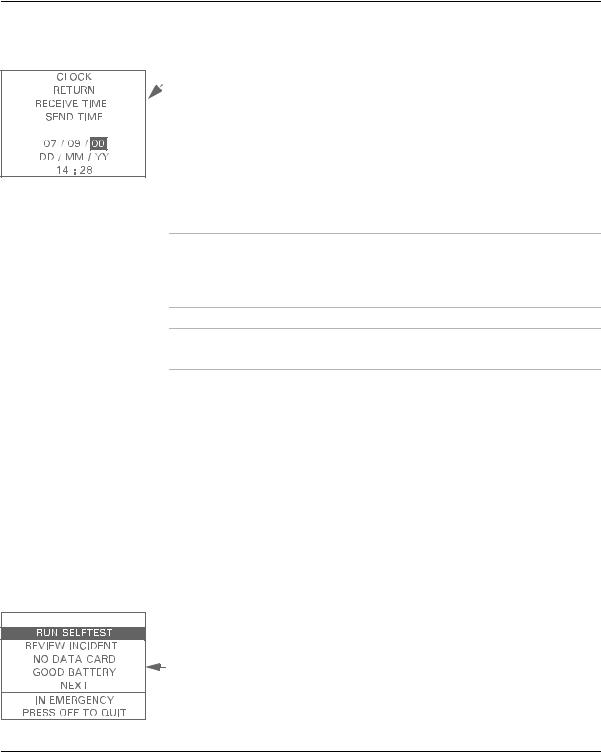
2-4
To manually set the clock:
1.Use the lower Option button to move the highlight bar to the part of the
clock setting you want to change.
2. Press the upper Option button repeatedly to scroll through the settings until you reach the one you want. If you go past it, keep scrolling until it comes up again.
3. Use the lower Option button to select the next part you want to change, and repeat the process, until all parts of the date and time have been set.
4.When you have made all the changes, move the highlight bar to RETURN and press the upper Option button to go back to the main menu screen.
N O T E : New clock settings are used by the FR2+ as soon as you set them. The clock time display is updated each minute this screen is displayed. The clock seconds, although not displayed, are set to 00 when you move the highlight bar out of the time settings.
N O T E : If the battery is removed from the FR2+ for more than two hours, the clock settings will be lost and must be reset.
Running the Battery Insertion Selftest
Except in an emergency, it is recommended that you run this selftest every time you change the battery. Make sure the defibrillator pads are not connected to the HeartStart FR2+ Defibrillator before running the battery insertion selftest.
The selftest has two parts. The first part automatically tests the FR2+ circuitry. The second part is interactive and requires you to respond to prompts in order to make sure the display, buttons, lights, speaker, and beeper of the FR2+ are working properly. (See Chapter 4, “Maintaining, Testing, and Troubleshooting Your HeartStart FR2+,” for details about this selftest.)
To run the selftest:
1. Make sure the defibrillator pads are not connected to the device.
2.Insert the battery into the battery port. The first screen displayed has RUN SELFTEST highlighted.
P hili ps Me dical Sy stems
M3860A/M3861A HEARTSTART FR2+
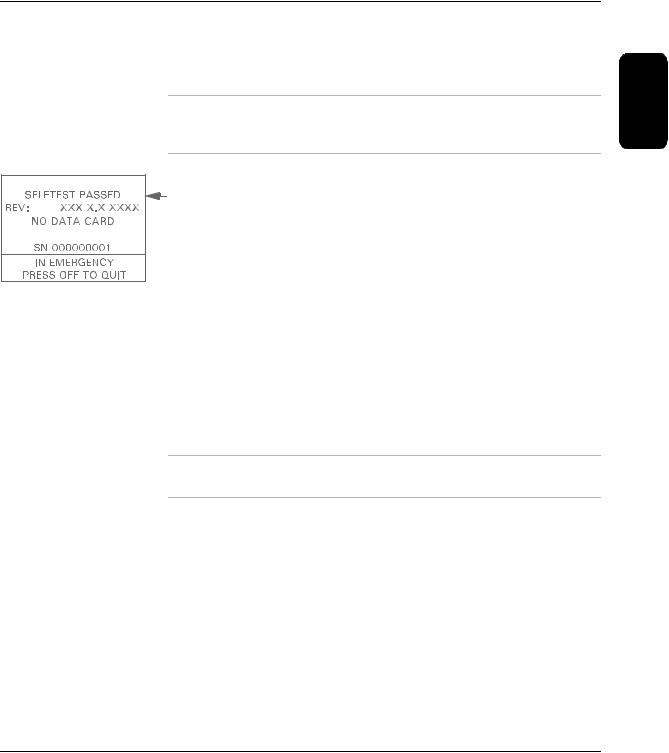
P hili ps Me dical Sy stems
2-5
GOOD BATTERY
3.Press the upper Option button to activate the test.
4.OR make no selection for 10 seconds, and the selftest will start automatically if the FR2+ has been turned off for at least 5 minutes.
2
N O T E : If you connect defibrillator pads (that are applied to the patient) to the FR2+ during a battery insertion selftest, the selftest will stop and the FR2+ will go to its standby mode to be ready for use.
When the automatic part of the selftest is successfully completed, the screen displays a message that the test has passed, and then automatically starts the interactive part of the selftest. It is important to press the buttons and verify the indicators to ensure that the FR2+ will be ready for use.
When the entire selftest is complete, the FR2+ automatically turns off and returns to standby mode. In the standby mode, the Status Indicator displays a flashing black hourglass. This means that the FR2+ has passed its most recent self-test and is therefore ready for use, simply by pressing the On/Off button to turn it on.
Placing and Securing the HeartStart FR2+
Place the HeartStart FR2+ Defibrillator in an accessible area with the Status Indicator easily visible. Useful accessories for placing and securing the FR2+ include a carrying case, which is suitable for use with a wall mount bracket or defibrillator cabinet. (See Appendix A for a list of accessories.)
N O T E : Do not store the FR2+ with the defibrillator pads attached. Do not open the pads package until ready for use.
With the battery installed and the FR2+ stored in appropriate environmental conditions, the FR2+ performs detailed periodic selftests to make sure that it remains ready for use. (See Appendix B for the environmental storage specifications.)
While the FR2+ is in the standby mode, the Status Indicator shows the flashing black hourglass unless the periodic selftests detect a problem. If a problem is detected, the Status Indicator will show a flashing red X or a solid red X and the FR2+ will beep (“chirp”) to alert you to the need for troubleshooting. (See Chapter 4, “Maintaining, Testing, and Troubleshooting Your HeartStart FR2+,” for instructions.)
Preparing Your HeartStart FR2+ for Use

Notes
P hili ps Me dical Sy stems
M3860A/M3861A HEARTSTART FR2+

3 Using Your HeartStart FR2+
Overview
This chapter describes how to use the HeartStart FR2+ Defibrillator in an emergency incident. Some general things to remember are:
Try to relax and stay calm. The FR2+ automatically provides appropriate voice and display prompts to guide you.
The defibrillator pads must have good contact with the patient’s skin. |
3 |
The pads have a layer of sticky, conductive gel beneath the protective backing. To work effectively, the gel must not be dried out.
It may be necessary to dry the patient’s skin or to clip or shave excessive chest hair to provide good contact between the defibrillator pads and the patient’s skin.
The following pages provide step-by-step instructions for normal use of the
FR2+ in an emergency. (See Chapter 4, “Maintaining, Testing, and
Troubleshooting Your HeartStart FR2+,” for troubleshooting tips.)
I M P O R T A N T : Be sure to read the Warnings and Cautions on the last page of this chapter.
N O T E : These directions apply to both the model M3860A and the model
M3861A FR2+, except where otherwise noted.
P hili ps Me dical Sy stems
3-1
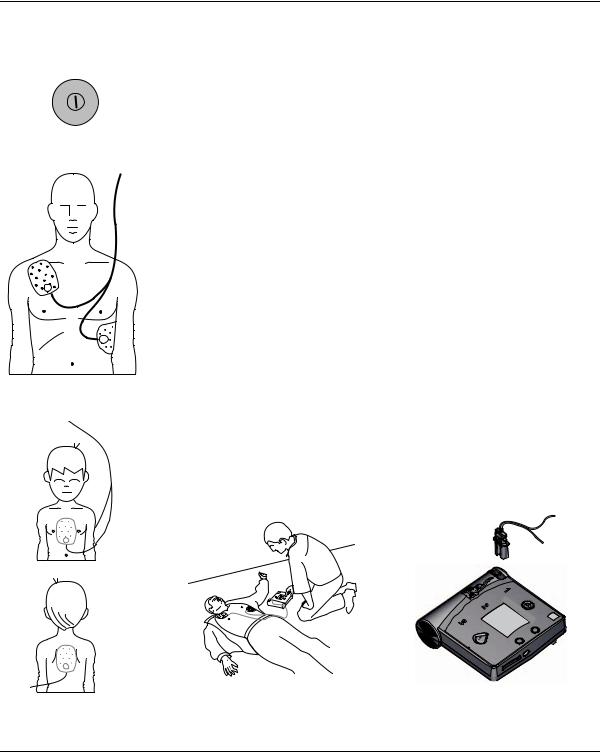
3-2
N O |
|
|
|
• |
|
|
F |
|
O |
|
F |
|
|
|
|
|
|
|
|
|
|
|
|
|
|
|
Step 1: Preparation
Press the On/Off button to turn on the HeartStart FR2+ Defibrillator. Follow the instructions provided by the FR2+ voice and screen prompts in the order indicated.
Remove clothing from the patient's upper body. Wipe moisture from the patient's skin and clip or shave excessive chest hair, if necessary.
If the patient appears to be under eight years of age or 55 lbs (25 Kg), use M3870A FR2 infant/child reduced-energy defibrillator pads, if available. If the child appears older/larger, use adult defibrillator pads. DO NOT DELAY TREATMENT TO DETERMINE THE CHILD’S EXACT AGE/WEIGHT.
Open the defibrillator pads package. Check to see that the pads and attached cable and connector are undamaged. Pull off the protective backing from the defibrillator pads and check that the gel has not dried out. If the pads are damaged or the gel has dried out, use a new set of pads.
Place each pad on the patient. The pads must be placed with the sticky side on the patient’s skin. I M P O R T A N T : Refer to the drawing on each pad for correct positioning. For adult patients, one pad goes just below the patient's right collarbone, and the other one goes over the patient’s ribs in line with the armpit and below the left breast. For children under eight years old, one pad is centered on the chest between the nipples, and the other on the back between the scapulae (shoulder bones).
Connect the pads to the FR2+. Insert the defibrillator pads connector firmly into the connector socket. A flashing light shows you where the socket is located, at the top left of the FR2+.
P hili ps Me dical Sy stems
M3860A/M3861A HEARTSTART FR2+
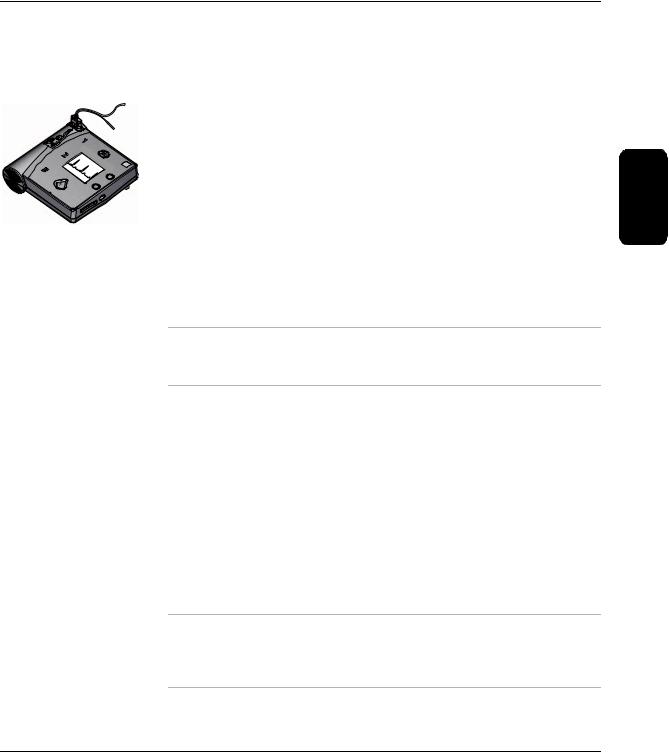
P hili ps Me dical Sy stems
3-3
Step 2: ECG Analysis and Monitoring
Follow the instructions provided by the HeartStart FR2+ Defibrillator’s voice and screen prompts in the order indicated.
As soon as the FR2+ detects that the defibrillator pads are connected |
|
properly, it automatically begins analyzing the patient’s heart rhythm. Do not |
|
touch the patient during rhythm analysis. The M3860A FR2+ can display the |
|
patient’s ECG on the screen. When the ECG display is enabled, the |
|
patient’s heart rate is also displayed during background monitoring and when |
3 |
the advanced mode is entered. |
If no shock is advised, the FR2+ provides voice and screen prompts to tell you so. The FR2+ instructs you to perform CPR if needed, and performs background monitoring of the patient’s ECG while you give appropriate care to the patient. These instructions are repeated at the programmed Monitor Prompt interval (the default interval is one minute) while the FR2+ is monitoring the patient.
N O T E : CPR may interfere with background monitoring. During CPR, periodically pause for 15 seconds to check the patient and allow the FR2+ to analyze the patient’s heart rhythm without CPR artifact.
Monitoring continues until and unless the FR2+ detects a change in the patient’s heart rhythm that may be a shockable rhythm, detects interference with rhythm analysis, or is turned off.
If the FR2+ detects a potentially shockable heart rhythm while monitoring, it automatically goes back to analyzing the rhythm to see if a shock is advised.
If a shock is advised, the FR2+ charges to prepare for shock delivery. It gives the voice warnings and screen prompts to tell you that a shock is advised. Make sure that no one is touching the patient or the pads. While the FR2+ is charging, it continues to analyze the patient’s heart rhythm. If the rhythm changes and a shock is no longer appropriate, the FR2+ disarms. Voice and display prompts advise you what action to take.
N O T E : When the FR2+ is fully charged, you can disarm it at any time by pressing the On/Off button to turn off the FR2+ and return it to standby mode. (See the Defibrillator discussion in Appendix B, “Technical Specifications,” for details on disarming the FR2+.)
Using Your HeartStart FR2+

3-4
Step 3: Shock Delivery
Press the Shock button to deliver the shock.
I M P O R T A N T : You must press the button for a shock to be delivered. The
HeartStart FR2+ Defibrillator will not automatically deliver a shock.
There are four ways you can tell that the FR2+ is ready to deliver a shock:
you hear a voice prompt telling you to deliver a shock,
you see the Shock button flashing,
you hear a steady tone, and/or
you see a screen prompt telling you to press the orange (Shock) button.
After you press the Shock button, a voice prompt tells you the shock was delivered. Then FR2+ goes back to analyzing the patient’s heart rhythm to see if the shock was successful. The FR2+ continues to provide voice and text prompts to guide you through additional shocks, if appropriate.
N O T E : If you do not press the Shock button within 30 seconds of being prompted, the FR2+ will disarm itself and provide a pause. The device will resume analyzing after 30 seconds or when the Resume Analyzing key is pressed.
Pause for CPR. After the programmed number of shocks in a shock series are delivered, the FR2+ automatically pauses for a programmed amount of time to allow you to perform CPR. After the voice and screen prompts tell you that the FR2+ has paused, there are no further voice prompts during the rest of the pause, so that you can provide uninterrupted patient care.
During the pause, the FR2+ screen shows a bar that fills in as the pause time is used up. The screen also shows how much time has gone by since the FR2+ was turned on,* and how many shocks have been delivered. The M3860A FR2+ also displays the ECG, if enabled, during this period.
*The FR2+ displays elapsed time to a maximum of 99:59 minutes. If the elapsed time of use extends beyond this figure, the minutes are represented by “??” but the seconds are displayed. However, total elapsed time will be recorded on an installed data card for later review with HeartStart Event Review data management software.
P hili ps Me dical Sy stems
M3860A/M3861A HEARTSTART FR2+

P hili ps Me dical Sy stems
3-5
ECG Display for Ongoing Observation
At the discretion of emergency care personnel, the M3860A FR2+ with ECG display enabled can also be used with the M3873A/M3874A FR2+ ECG assessment module. The FR2+ used with the FR2+ ECG assessment module provides a non-diagnostic ECG display of the patient’s heart rhythm for attended patient monitoring. The system is intended for use on a conscious or breathing patient, regardless of age. While connected to the FR2+ ECG assessment module, the FR2+'s shock capability is disabled, but the FR2+ continues to evaluate the patient's ECG. The module is
designed for connection to ECG electrodes per AAMI (M3873A) or IEC 3 (M3874A) color convention.
There are no known contraindications to use of the FR2+ ECG assessment module.
The module’s colored leadwires are connected to ECG electrodes, which are then placed on the patient’s bare chest, and the module’s device connector is inserted in the FR2+’s connector socket.
N O T E : It is not necessary to turn the FR2+ Defibrillator off prior to connecting the ECG assessment module.
Once connected, the FR2+ displays and evaluates the patient's ECG (Lead II). Follow all prompts from the FR2+. If a data card is used when the module is connected to the FR2+, all recorded events can be viewed using HeartStart Event Review data management software* on a personal computer.
Check the patient if:
indicated by the observed ECG display,
the patient becomes unresponsive or stops breathing, or
the FR2+ prompts IF NEEDED, ATTACH DEFIBRILLATION PADS.
If appropriate, unplug the ECG assessment module from the FR2+, attach the defibrillator pads to the patient, and connect the defibrillator pads to the FR2+. Verify that the defibrillator pads are at least one (1) inch (2.5 cm) away from the ECG electrodes.
The M3873A/M3874A FR2+ ECG assessment module contains no latex rubber. It is reusable (see the expiration date on the module) and can be cleaned with a soft cloth dampened with any of the agents recommended for
*HeartStart Event Review software was previously sold as CodeRunner software.
Using Your HeartStart FR2+

3-6
cleaning the FR2+ Defibrillator. (See Chapter 4, “Maintaining, Testing, and Troubleshooting Your HeartStart FR2+.”)
W AR NI NG : During defibrillation, air pockets between the skin and defibrillator pads can cause patient skin burns. To help prevent air pockets, make sure defibrillator pads completely adhere to the skin. Do not use dried-out defibrillator pads.
W AR NI NG : Do not let the defibrillator pads touch each other or other ECG electrodes, lead wires, dressings, transdermal patches, etc. Such contact can cause electrical arcing and patient skin burns during defibrillation and may divert defibrillating current away from the heart.
W AR NI NG : Handling or transporting the patient during heart rhythm analysis can cause an incorrect or delayed diagnosis. If the FR2+ gives a SHOCK ADVISED prompt, keep the patient as still as possible for at least 15 seconds so the FR2+ can reconfirm the rhythm analysis before a shock is delivered.
W AR NI NG : CPR rates significantly above 100 compressions per minute can cause incorrect or delayed analysis by the FR2+.
W AR NI NG : Defibrillation current can cause operator or bystander injury. Do not touch the patient during defibrillation. Do not allow the defibrillator pads to touch any metal surfaces. Disconnect the pads connector from the FR2+ before using any other defibrillator.
C A U T I O N : Aggressive handling of the pads in storage or prior to use can damage the pads. Discard the defibrillator pads if they become damaged.
P hili ps Me dical Sy stems
M3860A/M3861A HEARTSTART FR2+

P hili ps Me dical Sy stems
4Maintaining, Testing, and Troubleshooting Your HeartStart FR2+
Overview
This chapter provides information on HeartStart FR2+ Defibrillator maintenance, detailed descriptions of the selftests, and a guide to troubleshooting.
Maintenance
Maintenance of the FR2+ is very simple, but it is a very important factor in its dependability. The FR2+ performs many maintenance activities itself. These
include daily and weekly selftests to verify readiness for use and more 4 detailed monthly selftests that also verify the shock waveform delivery
system. In addition, a detailed selftest is run whenever a battery is installed in the FR2+.
The FR2+ requires no calibration or verification of energy delivery. The FR2+ has no user-serviceable parts.
C A U T I O N : Improper maintenance may damage the FR2+ or cause it to function improperly. Maintain the FR2+ only as described in this User's Guide or as designated by your program's Medical Director.
C A U T I O N : Electrical shock hazard. Dangerous high voltages and currents are present. Do not open the FR2+, remove its covers, or attempt repair. There are no user-serviceable components in the FR2+. The FR2+ should be returned to an authorized service center for repair.
The following table presents a schedule of suggested maintenance for the FR2+. Different frequency intervals may be appropriate, depending upon the environment in which the FR2+ is used. The required maintenance frequency is at the discretion of your program’s Medical Director.
4-1

4-2
daily |
monthly |
maintenance task/response |
|
|
|
|
|
Check the Status Indicator. |
|
|
If you see the flashing black hourglass: The FR2+ is |
|
|
ready to use. No action required. |
|
|
If you see anything other than a flashing black |
|
|
hourglass, remove and reinstall the battery to run the |
|
|
selftest. |
•If the selftest passes and the Status Indicator shows the flashing black hourglass, the FR2+ is ready to use.
•If the selftest fails, install a new battery and run the selftest. If the selftest passes, the FR2+ is ready to use. If the selftest fails, contact Philips Medical Systems.
Check supplies, accessories, and spares for damage and expiration dating.
Do not use damaged or expired accessories. Replace them immediately.
If a LOW BATTERY or REPLACE BATTERY message is displayed: Replace the battery and run the selftests.
DO NOT ATTEMPT TO CHARGE THE M3863A FR2
STANDARD BATTERY. It is not rechargeable. The M3848A FR2+ battery is rechargeable. Recharge it, using the M3849A Charger, for the FR2+ rechargeable battery only.
Check the outside of the FR2+ and the connector socket for cracks or other signs of damage.
If you see signs of damage: Contact Philips Medical Systems for technical support.
After Using the HeartStart FR2+
After each use of the FR2+, perform the maintenance tasks described in the table above, as well as the following post-use checks before returning the FR2+ to service:
Check the operation of the FR2+ by removing and reinstalling the battery and running the battery insertion selftest. N O T E : Perform also when replacing expired defibrillator pads.
Check the outside of the FR2+ and the connector socket for signs of dirt or contamination. If the FR2+ is dirty or contaminated, clean it according to the guidelines provided in this manual.
Check the data card if one has been used. If the data card has been used to record incident data, remove and replace it with a blank data card. Deliver the recorded data card to appropriate personnel according to your local guidelines and medical protocol.
P hili ps Me dical Sy stems
M3860A/M3861A HEARTSTART FR2+

P hili ps Me dical Sy stems
4-3
Check the connector socket to make sure that defibrillator pads are disconnected from the FR2+ when it is not in use.
Check to make sure the data card tray is installed, even if a data card is not being used.
Cleaning the HeartStart FR2+
The outside of the FR2+, including the defibrillator pads connector socket, can be cleaned with a soft cloth dampened in one of several appropriate cleaning agents (see list below). The following guidelines include some important reminders:
Do not immerse the FR2+ in fluids.
Make sure a battery (or the M3864A training & administration pack) and a data card tray are installed when cleaning the FR2+, to keep fluids out of the device.
Do not use abrasive materials, cleaners, strong solvents such as acetone |
4 |
|
or acetone-based cleaners, or enzymatic cleaners. |
||
|
Clean the FR2+ and the connector socket with a soft cloth dampened with one of the cleaning agents listed below.
—Isopropyl alcohol (70% solution)
—Soapy water
—Chlorine bleach (30 ml/l water)
—Ammonia-based cleaners
—Glutaraldehyde-based cleaners
—Hydrogen peroxide
C A U T I O N : Do not immerse any portion of the FR2+ in water or other fluids. Do not allow fluids to enter the FR2+. Avoid spilling any fluids on the FR2+ or accessories. Spilling fluids into the FR2+ may damage it or present a fire or shock hazard. Do not sterilize the FR2+ or accessories.
Operator’s checklist
The checklist on the following page is for your reference. You may want to photocopy it or use it as the basis for creating your own checklist.
Inspect the FR2+ as suggested in the maintenance schedule above, or as specified by your Medical Director. When you use the Checklist, fill in the scheduled frequency intervals you will be using for your maintenance inspections.
Check off each requirement as you complete it, make a note of any problems you found or corrective action you took, and sign the form.
Maintaining, Testing, and Troubleshooting Your HeartStart FR2+
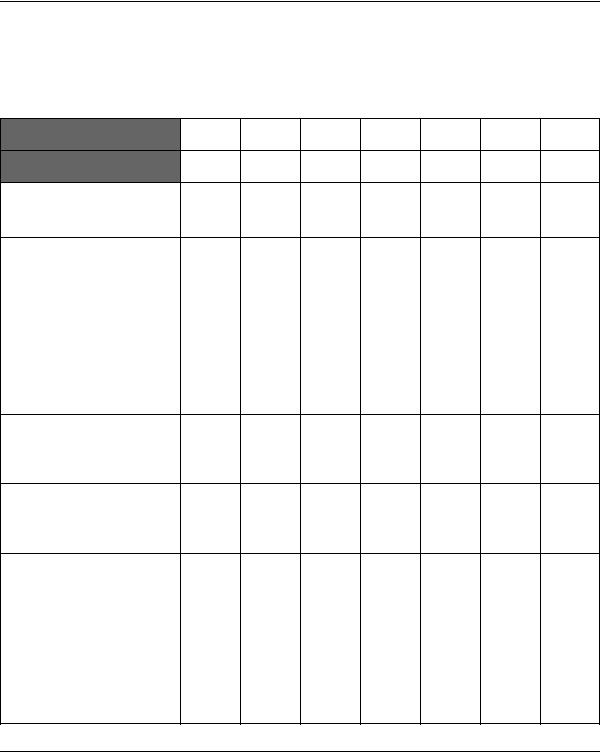
4-4
OPERATOR'S CHECKLIST
HeartStart FR2+ Model No.: ______________________Serial No.:__________________________________
HeartStart FR2+ Location or Vehicle ID: _______________________________________________________
date
scheduled frequency
HeartStart FR2+
Clean, no dirt or contamination; no signs of damage
Supplies Available
•Two sets defibrillator pads, sealed, undamaged, within expiration date
•Ancillary supplies (hand towel, scissors, razor, pocket mask, gloves)
•Spare M3863A battery, within “Install Before” date
•Data cards, undamaged, and spare data card tray
Status Indicator
Shows alternating hourglass/square; selftest passed.
Inspected by
Signature or initials of operator completing the maintenance inspection
Remarks, Problems,
Corrective Actions
P hili ps Me dical Sy stems
M3860A/M3861A HEARTSTART FR2+
